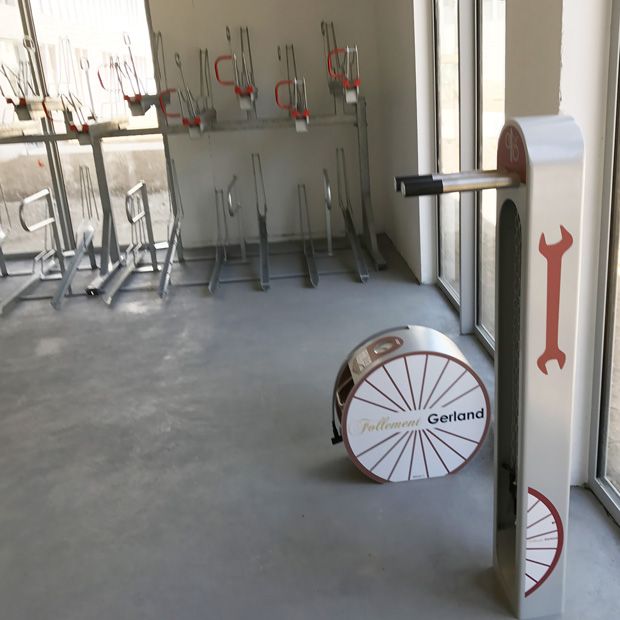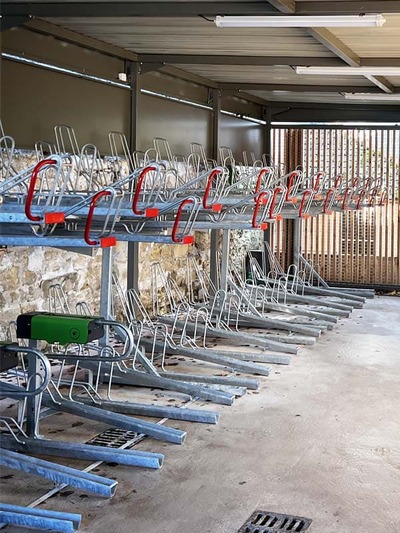With the rise of soft mobility and the gradual reduction in the use of cars in town centres, more and more co-owners are considering theinstallation of a secure bicycle storage area. This project meets a number of challenges:
- ✔ Secure bicycle parking
- ✔ Encouraging environmentally friendly travel
- ✔ Enhance the value of the building and attract new buyers or tenants
But where should you start? What are the legal obligations? How do you convince the other co-owners? Follow this practical guide to make your project a success!
Understand the legal framework: requirements for a bike room in co-ownership properties
In both the United Kingdom and the United States, regulations encourage or require the provision of secure, accessible, and weather-protected bicycle parking in residential developments.
- In the UK, national guidelines like the Local Transport Note 1/20 (LTN 1/20) recommend providing at least one secure bicycle parking space per dwelling. Facilities must be accessible, covered, and allow bikes to be locked by both the frame and wheel.
- In the US, requirements vary by city. For example, cities like Washington D.C. and New York City mandate a minimum number of secure bike parking spaces for residential buildings, often linked to the number of housing units. These spaces must be weather-protected and easily accessible.
Identify residents’ needs
Before launching the project, it is essential to gather feedback from the residents:
- ✔ How many residents use a bicycle?
- ✔ What types of bikes need to be stored? (Standard bikes, electric bikes, cargo bikes…)
- ✔ What are the key requirements? (Security, quick access, sufficient space)
Tip: conduct a survey among co-owners to assess their expectations and level of commitment; it will also give you an idea of the potential approval of your proposal during the general meeting.

Définir les solutions adaptées
Define the appropriate solutions
Two main options are available:
✔ A secure bike room inside the building (converted from an old room or unused space)
✔ An independent outdoor bike shelter
Each solution must meet the needs of the co-ownership while complying with applicable standards.

Analyze the available space
A bike room can be created using various existing spaces:
✔ An old cellar or underused technical room that can be converted into a bike garage;
✔ A section of the underground parking area where a closed structure with racks can be installed;
✔ A car parking space converted into a secure bike parking area;
✔ An outdoor area suitable for installing a secure shelter.
Calculate the budget and possible financing options
It is important to be aware of the scale of your project. For example, fitting out an existing room typically costs between €3,000 and €10,000, depending on the equipment installed. In the case of installing an outdoor bike shelter in a co-ownership property, the cost usually ranges from €5,000 to €15,000.
Find out about available financing options. There are grants and local subsidies (to be checked with your town hall, regional authorities). It is also possible to apply for tax credits for co-ownership properties committed to promoting sustainable mobility.
Tip: Some service providers offer turnkey solutions with payment facilities.
Have the project approved at the general meeting
To be approved, the bike room project in a co-ownership property must be submitted to a vote at the general meeting.
Required majority for approval at the general meeting:
- → If the installation is mandatory (parking area with more than 10 spaces and planned renovation works) → Simple majority.
- → If the installation is optional → Absolute majority (50% +1 of all co-owners’ votes).
Tip – Prepare a detailed file before the general meeting, including:
- ✔ A detailed quote
- ✔ A development plan
- ✔ A list of benefits for the co-ownership
Start the work and inform the residents
Une fois le vote validé :
- → Choisissez un prestataire spécialisé dans les installations de stationnements vélos.
- → Informez les habitants du planning des travaux.
- → Assurez un suivi de chantier pour garantir un respect des délais et du budget.